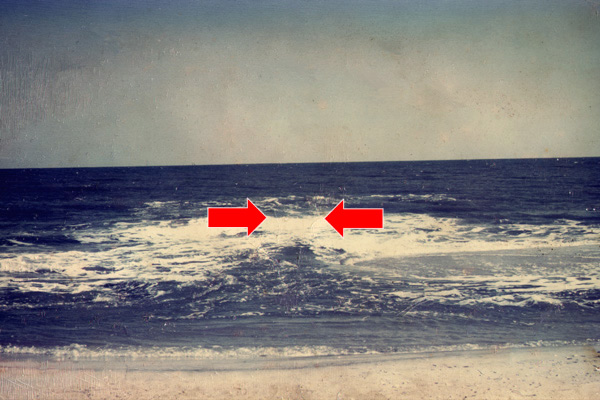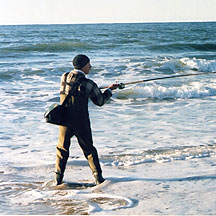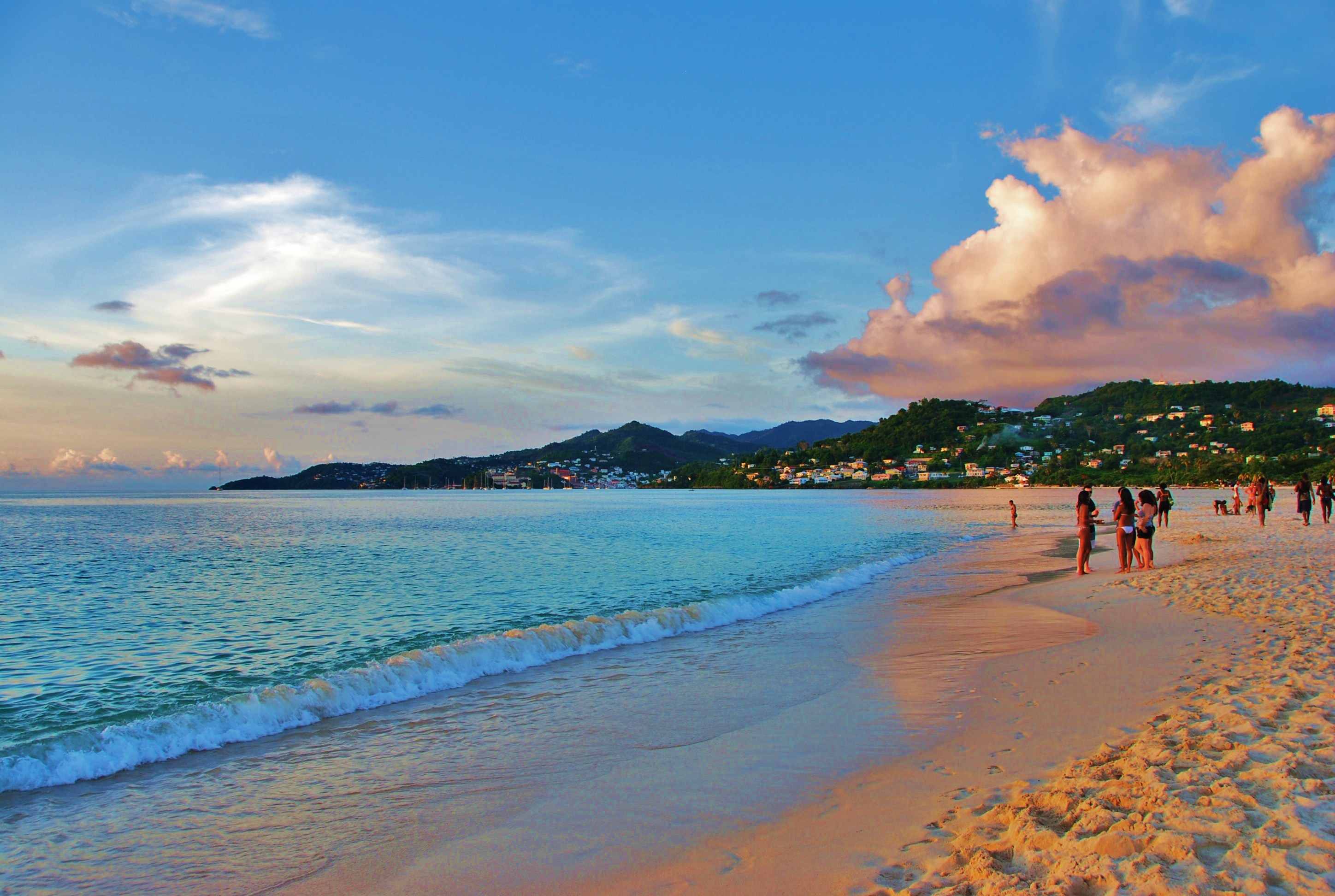|
Surf Zone
As ocean surface waves approach shore, they get taller and break, forming the foamy, bubbly surface called ''surf''. The region of breaking waves defines the surf zone, or breaker zone. After breaking in the surf zone, the waves (now reduced in height) continue to move in, and they run up onto the sloping front of the beach, forming an uprush of water called swash. The water then runs back again as backwash. The nearshore zone where wave water comes onto the beach is the surf zone. The water in the surf zone is shallow, usually between deep; this causes the waves to be unstable. Animal life The animals that often are found living in the surf zone are crabs, clams, and snails. Surf clams and mole crabs are two species that stand out as inhabitants of the surf zone. Both of these animals are very fast burrowers. The surf clam, also known as the variable coquina, is a filter feeder that uses its gills to filter microalgae, tiny zooplankton, and small particulates out of seawater ... [...More Info...] [...Related Items...] OR: [Wikipedia] [Google] [Baidu] |
Ocean Surface Wave
In fluid dynamics, a wind wave, water wave, or wind-generated water wave, is a surface wave that occurs on the free surface of bodies of water as a result from the wind blowing over the water surface. The contact distance in the direction of the wind is known as the ''fetch''. Waves in the oceans can travel thousands of kilometers before reaching land. Wind waves on Earth range in size from small ripples, to waves over high, being limited by wind speed, duration, fetch, and water depth. When directly generated and affected by local wind, a wind wave system is called a wind sea. Wind waves will travel in a great circle route after being generated – curving slightly left in the southern hemisphere and slightly right in the northern hemisphere. After moving out of the area of fetch, wind waves are called '' swells'' and can travel thousands of kilometers. A noteworthy example of this is waves generated south of Tasmania during heavy winds that will travel across the Pacif ... [...More Info...] [...Related Items...] OR: [Wikipedia] [Google] [Baidu] |
Mole Crabs
Hippoidea is a superfamily of decapod crustaceans known as sand crabs or mole crabs. Ecology Hippoids are adapted to burrowing into sandy beaches, a habit they share with raninid crabs, and the parallel evolution of the two groups is striking. In the family Hippidae, the body is almost ovoid, the first pereiopods have no claws, and the telson is long, none of which are seen in related groups. Unlike most other decapods, sand crabs cannot walk; instead, they use their legs to dig into the sand. Members of the family Hippidae beat their uropods to swim. Apart from the polar regions, hippoids can be found on beaches throughout the world. Larvae of one species have also been found in Antarctic waters, despite the lack of suitable sandy beaches in the Antarctic. Classification Alongside hermit crabs and allies (Paguroidea), squat lobsters and allies (Galatheoidea) and the hairy stone crab (''Lomis hirta'', Lomisoidea), Hippoidea is one of the four groups that make up the infraorde ... [...More Info...] [...Related Items...] OR: [Wikipedia] [Google] [Baidu] |
Coastal Geography
Coastal geography is the study of the constantly changing region between the ocean and the land, incorporating both the physical geography (i.e. coastal geomorphology, climatology and oceanography) and the human geography (sociology and history) of the coast. It includes understanding coastal weathering processes, particularly wave action, sediment movement and weather, and the ways in which humans interact with the coast. Wave action and longshore drift The waves of different strengths that constantly hit against the shoreline are the primary movers and shapers of the coastline. Despite the simplicity of this process, the differences between waves and the rocks they hit result in hugely varying shapes. The effect that waves have depends on their strength. Strong waves, also called destructive waves, occur on high-energy beaches and are typical of winter. They reduce the quantity of sediment present on the beach by carrying it out to bars under the sea. Constructive, weak waves ... [...More Info...] [...Related Items...] OR: [Wikipedia] [Google] [Baidu] |
Surf Fishing
Surf fishing is land-based game fishing while standing on the shoreline or wading into the surf zone. A general term, surf fishing may or may not include casting a lure or bait, and refers to all types of shore fishing – from sandy and rocky beaches, rock jetties, or even fishing piers. The terms surfcasting or beachcasting refer more specifically to surf fishing from the beach by casting into the surf at or near the shoreline. With few exceptions, surf fishing is done in saltwater. The most common misconception about surf fishing is the idea that one must cast as far out as possible in order to reach the fish. At beaches on the west coast of the United States, and in fact, at most beaches around the world, you only really need to get your bait into knee-deep water. This is referred to as surf fishing the "skinny" (the skinny water). Equipment The basic idea of most surfcasting is to cast a bait or lure as far out into the water as is necessary to reach the target fish f ... [...More Info...] [...Related Items...] OR: [Wikipedia] [Google] [Baidu] |
Littoral Zone
The littoral zone or nearshore is the part of a sea, lake, or river that is close to the shore. In coastal ecology, the littoral zone includes the intertidal zone extending from the high water mark (which is rarely inundated), to coastal areas that are permanently submerged — known as the ''foreshore'' — and the terms are often used interchangeably. However, the geographical meaning of ''littoral zone'' extends well beyond the intertidal zone to include all neritic waters within the bounds of continental shelves. Etymology The word ''littoral'' may be used both as a noun and as an adjective. It derives from the Latin noun ''litus, litoris'', meaning "shore". (The doubled ''t'' is a late-medieval innovation, and the word is sometimes seen in the more classical-looking spelling ''litoral''.) Description The term has no single definition. What is regarded as the full extent of the littoral zone, and the way the littoral zone is divided into subregions, varies in different c ... [...More Info...] [...Related Items...] OR: [Wikipedia] [Google] [Baidu] |
Intertidal Zone
The intertidal zone, also known as the foreshore, is the area above water level at low tide and underwater at high tide (in other words, the area within the tidal range). This area can include several types of habitats with various species of life, such as seastars, sea urchins, and many species of coral with regional differences in biodiversity. Sometimes it is referred to as the ''littoral zone'' or '' seashore'', although those can be defined as a wider region. The well-known area also includes steep rocky cliffs, sandy beaches, bogs or wetlands (e.g., vast mudflats). The area can be a narrow strip, as in Pacific islands that have only a narrow tidal range, or can include many meters of shoreline where shallow beach slopes interact with high tidal excursion. The peritidal zone is similar but somewhat wider, extending from above the highest tide level to below the lowest. Organisms in the intertidal zone are adapted to an environment of harsh extremes, living in water pr ... [...More Info...] [...Related Items...] OR: [Wikipedia] [Google] [Baidu] |
Pier
image:Brighton Pier, Brighton, East Sussex, England-2Oct2011 (1).jpg, Seaside pleasure pier in Brighton, England. The first seaside piers were built in England in the early 19th century. A pier is a raised structure that rises above a body of water and usually juts out from its shore, typically supported by piling, piles or column, pillars, and provides above-water access to offshore areas. Frequent pier uses include fishing, boat docking and access for both passengers and cargo, and oceanside recreation. Bridges, buildings, and walkways may all be supported by Pier (architecture), architectural piers. Their open structure allows tides and currents to flow relatively unhindered, whereas the more solid foundations of a quay or the closely spaced piles of a wharf can act as a Breakwater (structure), breakwater, and are consequently more liable to silting. Piers can range in size and complexity from a simple lightweight wooden structure to major structures extended over . In Amer ... [...More Info...] [...Related Items...] OR: [Wikipedia] [Google] [Baidu] |
Jetties
A jetty is a structure that projects from land out into water. A jetty may serve as a breakwater, as a walkway, or both; or, in pairs, as a means of constricting a channel. The term derives from the French word ', "thrown", signifying something thrown out. For regulating rivers Another form of jetties, wing dams are extended out, opposite one another, ''from each bank of a river'', at intervals, to contract a wide channel, and by concentration of the current to produce a deepening. At the outlet of tideless rivers Jetties have been constructed on each side of the outlet river of some of the rivers flowing into the Baltic, with the objective of prolonging the scour of the river and protecting the channel from being shoaled by the littoral drift along the shore. Another application of parallel jetties is in lowering the bar in front of one of the mouths of a deltaic river flowing into a tide — a virtual prolongation of its less sea, by extending the scour of the rive ... [...More Info...] [...Related Items...] OR: [Wikipedia] [Google] [Baidu] |
Rip Current
A rip current, often simply called a rip (or misleadingly a ''rip tide''), is a specific kind of water current that can occur near beaches with breaking waves. A rip is a strong, localized, and narrow current of water which moves directly away from the shore, cutting through the lines of breaking waves like a river running out to sea. The current in a rip is strongest and fastest next to the surface of the water. Rip currents can be hazardous to people in the water. Swimmers who are caught in a rip current and who do not understand what is happening, or who may not have the necessary water skills, may panic, or they may exhaust themselves by trying to swim directly against the flow of water. Because of these factors, rip currents are the leading cause of rescues by lifeguards at beaches, and in the United States, they are the cause of an average of 46 deaths by drowning per year. A rip current is not the same thing as undertow, although some people use the term incorrectly whe ... [...More Info...] [...Related Items...] OR: [Wikipedia] [Google] [Baidu] |
Zooplankton
Zooplankton are the animal component of the planktonic community ("zoo" comes from the Greek word for ''animal''). Plankton are aquatic organisms that are unable to swim effectively against currents, and consequently drift or are carried along by currents in the ocean, or by currents in seas, lakes or rivers. Zooplankton can be contrasted with phytoplankton, which are the plant component of the plankton community ("phyto" comes from the Greek word for ''plant''). Zooplankton are heterotrophic (other-feeding), whereas phytoplankton are autotrophic (self-feeding). This means zooplankton cannot manufacture their own food but must eat other plants or animals instead — in particular they eat phytoplankton. Zooplankton are generally larger than phytoplankton, most are microscopic, but some (such as jellyfish) are macroscopic and can be seen with the naked eye. Many protozoans (single-celled protists that prey on other microscopic life) are zooplankton, including zooflagellates, fo ... [...More Info...] [...Related Items...] OR: [Wikipedia] [Google] [Baidu] |
Snails
A snail is, in loose terms, a shelled gastropod. The name is most often applied to land snails, terrestrial pulmonate gastropod molluscs. However, the common name ''snail'' is also used for most of the members of the molluscan class Gastropoda that have a coiled shell that is large enough for the animal to retract completely into. When the word "snail" is used in this most general sense, it includes not just land snails but also numerous species of sea snails and freshwater snails. Gastropods that naturally lack a shell, or have only an internal shell, are mostly called ''slugs'', and land snails that have only a very small shell (that they cannot retract into) are often called ''semi-slugs''. Snails have considerable human relevance, including as food items, as pests, and as vectors of disease, and their shells are used as decorative objects and are incorporated into jewelry. The snail has also had some cultural significance, tending to be associated with lethargy. The snai ... [...More Info...] [...Related Items...] OR: [Wikipedia] [Google] [Baidu] |
Shore
A shore or a shoreline is the fringe of land at the edge of a large body of water, such as an ocean, sea, or lake. In physical oceanography, a shore is the wider fringe that is geologically modified by the action of the body of water past and present, while the beach is at the edge of the shore, representing the intertidal zone where there is one. In contrast to a coast, a shore can border any body of water, while the coast must border an ocean or a sea. Therefore, in that sense, a coast is a type of shore. However, the word "coast" often refers to an area far wider than the shore, often stretching miles into the interior. Shores are influenced by the topography of the surrounding landscape, as well as by water induced erosion, such as waves. The geological composition of rock and soil dictates the type of shore which is created. Rivieras ''Riviera'' is an Italian word for "shoreline", ultimately derived from Latin ''ripa'' ("riverbank"). It came to be applied as a proper n ... [...More Info...] [...Related Items...] OR: [Wikipedia] [Google] [Baidu] |






.jpg)

